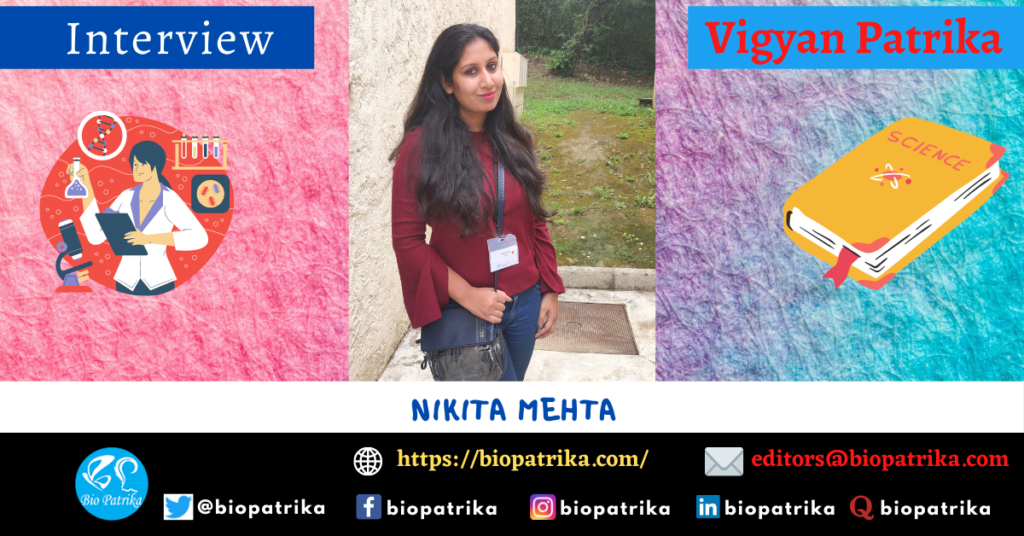Nikita Mehta’s interview with Bio Patrika hosting “Vigyan Patrika”, a series of author interviews. Nikita is a Ph.D. student in Dr. Abhishek Baghela’s lab at Biodiversity and Palaeobiology Group, Agharkar Research Institute, Pune, India. Her research aims to decipher the molecular mechanisms underlying the genetic diversity in a fungal plant pathogen, Colletotrichum gloeosporioides. Originally, she is from Bhilwara, Rajasthan, India, where she completed B.Sc. in Biotechnology from Rajasthan University, Jaipur, and M.Sc. in Biotechnology from Suresh Gyan Vihar University, Jaipur. Here she talks about her first-author research article published in the IMA Fungus (2021).
How would you explain your paper’s key results to the non-scientific community?
The Colletotrichum is one of the vital plant pathogenic fungi worldwide. Among different species, Colletotrichum gloeosporioides and C. siamense cause anthracnose disease in a broad range of plants, mainly fruits, and vegetables. Various works of the literature demonstrated the high genetic and pathogenic diversity in C. gloeosporioides strains across India. The possible mechanism that furnishes such high genetic diversity could be meiosis during sexual reproduction; however, it has been demonstrated that sexual reproduction in C. gloeosporioides and C. siamense in nature is rare, if not absent.
Under favorable conditions, a conidium forms a germ tube that elongates and branches to a hyphal network, further establishing the fungal colony. However, under starvation conditions, the fungal conidia in close proximity form specialized short hyphae, known as conidial anastomosis tube (CAT). These CATs are whispered to assist horizontal gene transfer between different fungal species. Through the CATs, DNA gets transferred from one fungus to another. CAT also facilitates the sharing of water, nutrients, signal molecules, organelles, and genetic material, among conidia. Many asexual plant pathogenic fungi undergo CAT fusion. It has been hypothesized that CAT fusion might play a vital role in the fungal life cycle for survival during nutrient starvation. The CAT fusion has been implicated in the generation of fungal hybrids (Figure 1).

We discovered the CAT fusion in C. gloeosporioides and C. siamense and found that the CAT fusion frequency between these two different fungal species was higher than CAT fusion in the same species. We observed that the older conidia were more efficient for CAT fusion than the younger conidia when put in appropriate numbers (quorum). Thus CAT fusion was dependent on conidial numbers and involved in a quorum sensing phenomenon, wherein the conidia sense their density and secretes quorum-sensing molecule. We demonstrated that the CAT fusion occurred in the absence of nutrients and the presence of stress conditions such as oxidative and osmotic stresses. We showed different stages of CAT viz. CAT induction, homing, and fusion. We also showed the transfer of various organelles viz. nuclei, mitochondria, and lipid droplets through CATs between C. gloeosporioides and C. siamense. We illustrated the possible role of CAT fusion in the generation of phenotypic and genetic variations in the C. gloeosporioides and C. siamense, leading to the formation of heterokaryotic progenies suggesting a genetic exchange between these species through CAT fusion. The heterokaryotic progenies were shown to exhibit varied fitness under stress conditions.
minimize the genetic variations via horizontal gene transfer and effective management of fungal pathogens in agricultural practices.
What are the possible consequences of these findings for your research area?
Our study will help to understand the mechanism of DNA/genetic transfer, parasexuality, and formation of novel hybrids/heterokaryons in asexual fungi. CAT fusion results in the transfer of pathogenicity genes and chromosomes between fungi through horizontal gene transfer, leading to the novel hybrid formation. The genetic transfer between the species is a fast means of genome evolution that enables organisms to accumulate novel traits to colonize new niches and hosts. Understanding the CAT fusion process will help develop certain drugs targeting and blocking this phenomenon. Thus, it will minimize the genetic variations via horizontal gene transfer and effective management of fungal pathogens in agricultural practices.
What was the exciting moment (eureka moment) during your research?
Initially, we started with only one fungal species, which showed a significantly lower CAT fusion percentage. However, when we studied CAT fusion between two different Colletotrichum species, it was our eureka moment as we observed very high CAT fusion frequency compared to CAT fusion within species. We were thrilled to see this result, and we concluded that CAT fusion is preferred between species compared to within species for nutrients and genetic material sharing.
What do you hope to do next?
Our novel findings have opened up several new areas of investigation. Further, I wish to venture into research focusing on identifying the molecular pathways and signals responsible for CAT fusion and understanding the complete mechanism of CAT fusion by which the fungal recombinants/hybrids are generated in the laboratory and nature.
Where do you seek scientific inspiration?
My primary scientific inspiration comes from my PI, lab members, advisers, and peers. I am always encouraged by brilliant scientists doing fantastic work in the Fungal biology field. My mentor always guided me, instilled scientific aptitude and rigor in me, and acted as a constant fuel for my scientific quest. These things motivate me to work harder and add a modest to our field’s growing knowledge.
How do you intend to help Indian science improve?
I wish to explore new tools and technologies worldwide to make the research more convenient and fruitful and transit these techniques to India. These advanced studies will help to answer the basic fundamental questions in the field of Fungal biology. I believe that science is boundary-less; scientists will always discover systems to collaborate beyond boundaries to attain brilliance. Therefore, I would like to add to Indian science by inculcating scientific temperament in young minds and propagating rational thinking culture amongst the general public. I would also like to participate in activities that can motivate Indian students to shape their scientific journey remarkably.
Reference
Mehta, N., Baghela, A. Quorum sensing-mediated inter-specific conidial anastomosis tube fusion between Colletotrichum gloeosporioides and C. siamense. IMA Fungus, 12, 7 (2021). DOI: https://doi.org/10.1186/s43008-021-00058-y.
Email: nikitamehta508@gmail.com
Edited by: Manveen K Sethi
